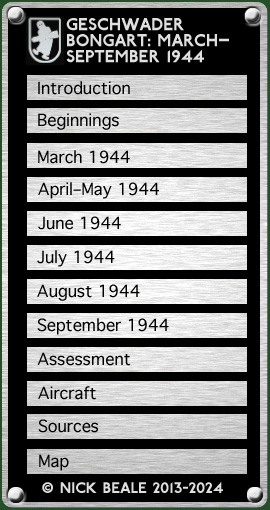|
Oyonnax (198 km ENE Clermont-Ferrand) was bombed and strafed by German aircraft on the 12th and again the next day, leading to serious damage and one death. This was later reported in the Swiss newspaper Nouvelliste valaisan:
When later a Gazette de Lausanne reporter visited the town, he noted that: “one bomb fell in front of the church porch without damaging the holy place. On the way out of the village an area, said to be a landing ground, has been ploughed up by the bombs; an electricity plant has been burned at the same time as the neighbouring farms”. On the Vercors plateau that evening: … we’re overflown by a German plane which heads for La Chapelle … which it bombs and shoots up in a great many passes, causing one fatality and several wounded, one very serious who will not survive. The day’s sorties totalled 28, against targets described as “in the area[s] Limoges and St. Claude”. Four more sorties were flown by KG 100. One Re. 2002 was accidentally damaged during an operational flight. 13 July The Geschwader again flew 28 anti-guerilla sorties, at least some of which were from Valence against Vassieux-en-Vercours (where the Resistance was constructing a landing strip for expected Allied supply flights) and La Chapelle. One such attack came at 19.00 hrs. local time (17.00 GMT) as three Résistants were working on a new emplacement by the airstrip: … two German bombers appear, coming from the St. Alexis pass … Without any great conviction [the Résistants] fire their rifles, regretting bitterly that the machine gun has still not been installed … On their first pass each bomber releases a bomb. One goes off in the direction of Les Pouyettes, the other falls toward the post [office]. The two planes make a turn and then come back on the same line to pass over our heads. We fire for form’s sake, well aware that it would take extraordinary luck to hit the pilot or a vital part of the plane. They drop a stick of four bombs per aircraft. One of them falls in the village [Vassieux], not far from the church, the others once again in the direction of Les Pouyettes … Seeing that the German planes are leaving, we rush into the village, all three of us, to see if anyone needs help. Three civilians were dead while another was gravely injured, as was the Resistance leader “Payot” (Pierre Point) who later succumbed; a dozen or so civilians with lesser injuries were loaded on to a lorry. A German fighter appeared but seems not to have spotted them among the trees. An hour after the wounded had been sent off to the hospital in Saint-Martin-en-Vercors, German aircraft returned to bomb Vassieux but most of the bombs went wide and no one was hurt. The consensus was that they were after the post office which also served as a Resistance command post. At around 21.20 (local time) two German aircraft bombed and shot up Monestier de Clermont (53 km east of Valence-La Trésorerie), injuring several inhabitants, in retaliation for an ambush on a military convoy. These machines were probably from II./KG 26: Ju 88 1H+IM dropped two 500 kg bombs on a “terrorist village” in sorties from Valence between 20.09 and 20.50, and was hit in the fusleage by a machine gun bullet.
Kommodore, Oberst von dem Bongart was injured when the Storch he was piloting (Fi 156 C-3 W.Nr. 1732) crashed on take-off from Bourg-en-Bresse, in the Ain Département, and was 80% damaged. The 157. Res. Div. had reported being active against partisans in the Bourg area the day before. A fragmentary report described the units and aircraft present at Châteauroux: An unspecified 2. Staffel (evidently 2./ZG 1) was commanded by Hptm. Willmy and all its aircraft were unserviceable. 11./Geschwader Bongart (Kapitän, Hptm. Wichelhaus): one Ju 88 A-5, one He 111, one Do 17, one Bf 108 and a Fi 156. 12./Geschwader Bongart (Kapitän, Obltn. Wallbrönn): four Bf 109, three Go 145, one He 46, two Bf 108 and a W. 34 Hi. All these elements were due to move out the following day: 50 men of 2./ZG 1 would return to Germany (an earlier message had mentioned Marx as a destination), the two Bongart Staffeln (with 200 personnel) were to transfer to Clermont-Ferrand. Statistics for Fl.ZG 2 include a "Fi" (presumably a Fi 156) on an operational flight destroyed due to accidental causes. Late in the morning, KG 100’s Operations Officer contacted his opposite number at X. Fliegerkorps to advise that several drops of FX guided bombs from Do 217 M-11s had failed so there was an urgent need to rewire the aircraft and carry out test drops. This message concluded: “On request of the Security Service, the target is to be the crossroads.” The reference to the Sicherheitsdienst suggests that this was to be a Resistance target and it is interesting that it should be mentioned alongside guided weapons — possibly this was intended to be a precision strike on the unnamed intersection.
Signals during the day mentioned a Bf 110 of IV./Geschwader Bongart, W.Nr. 3038, at Châteauroux. The IV. Gruppe also asked Paris-Villacoublay whether Bf 109 G-5 W.Nr. 11039 and Bf 109 G-12 W.Nr. 360390 were serviceable and ready for collection.
continued on next page …
|
|||||


